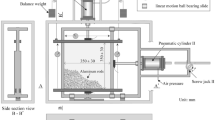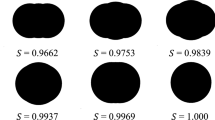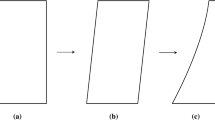Abstract
The shear strength of granular materials has been found to increase nonlinearly with particle asphericity before reaching a steady value independent of particle asphericity. Although the origin of shear strength has been extensively studied, the underlying mechanism of its nonlinear dependency on particle shape remains unclear. In this study, we present a microscopic investigation of shape-dependent shear strength from the perspective of particle dynamics. A series of numerical simple shear tests on assemblies of ellipsoids with different aspect ratios are performed using the discrete element method. It is confirmed that the power-law scaling in nonlocal granular rheology is still valid for granular materials composed of non-spherical particles, such that the macroscopic shear strength and microscopic dynamics can be bridged using granular temperature. Analogous to other amorphous solids, granular materials with higher granular temperature are much softer and exhibiting less resistance to shear. The statistics of the clusters of the particles with higher granular temperature indicate that granular systems with different particle shapes showing different collective motion patterns. We further explore the coupling between rotational and translational particle dynamics and their long-range correlations. The macroscopic shear strength shows a clear monotonic relation with the intrinsic length scale reflecting long-range dynamic correlations. Finally, we propose a picture illustrating the negative feedback mechanism between particle rolling and sliding, which leads to the nonlinear increase and steady value of shear strength with particle asphericity. Our finding may shed light not only on the particle shape effects, but also on the fundamental understanding of the microscopic origin of shear strength of granular materials.












Similar content being viewed by others
References
Ai J, Chen J, Rotter JM, Ooi JY (2011) Assessment of rolling resistance models in discrete element simulations. Powder Technol 206:269–282. https://doi.org/10.1016/j.powtec.2010.09.030
Alshibli KA, Asce M, Cil MB (2018) Influence of particle morphology on the friction and dilatancy of sand. J Geotech Geoenviron Eng 144:04017118. https://doi.org/10.1061/(ASCE)GT.1943-5606.0001841
Arda C, Cinicioglu O (2021) Influence of grain shape on stress-dilatancy parameters. Granul Matter 23:1–19. https://doi.org/10.1007/s10035-021-01098-2
Azéma E, Estrada N, Radjaï F (2012) Nonlinear effects of particle shape angularity in sheared granular media. Phys Rev E Stat Nonlinear Soft Matter Phys 86:041301. https://doi.org/10.1103/PhysRevE.86.041301
Azéma E, Radjaï F (2010) Stress-strain behavior and geometrical properties of packings of elongated particles. Phys Rev E Stat Nonlinear Soft Matter Phys 81:051304. https://doi.org/10.1103/PhysRevE.81.051304
Azéma E, Radjaï F, Peyroux R, Saussine G (2007) Force transmission in a packing of pentagonal particles. Phys Rev E Stat Nonlinear Soft Matter Phys 76:011301. https://doi.org/10.1103/PhysRevE.76.011301
Barrett PJ (1980) The shape of rock particles, a critical review. Sedimentology 27:291–303. https://doi.org/10.1111/j.1365-3091.1980.tb01179.x
Binaree T, Azéma E, Estrada N et al (2020) Combined effects of contact friction and particle shape on strength properties and microstructure of sheared granular media. Phys Rev E 102:22901. https://doi.org/10.1103/PhysRevE.102.022901
Blodgett ME, Egami T, Nussinov Z, Kelton KF (2015) Proposal for universality in the viscosity of metallic liquids. Sci Rep 5:13837. https://doi.org/10.1038/srep13837
Boton M, Azéma E, Estrada N et al (2013) Quasistatic rheology and microstructural description of sheared granular materials composed of platy particles. Phys Rev E Stat Nonlinear Soft Matter Phys 87:032206. https://doi.org/10.1103/PhysRevE.87.032206
Chen Y, Ma G, Zhou W et al (2021) An enhanced tool for probing the microscopic behavior of granular materials based on X-ray micro-CT and FDEM. Comput Geotech 132:103974. https://doi.org/10.1016/j.compgeo.2020.103974
Chen H, Zhao S, Zhao J, Zhou X (2021) The microscopic origin of K0 on granular soils: the role of particle shape. Acta Geotech 16:2089–2109. https://doi.org/10.1007/s11440-021-01161-5
Chikkadi V, Mandal S, Nienhuis B et al (2012) Shear-induced anisotropic decay of correlations in hard-sphere colloidal glasses. EPL. https://doi.org/10.1209/0295-5075/100/56001
Cho G-C, Dodds J, Santamarina JC (2006) Particle shape effects on packing density, stiffness, and strength: natural and crushed sands. J Geotech Geoenviron Eng 132:591–602. https://doi.org/10.1061/(asce)1090-0241(2006)132:5(591)
Dai BB, Yang J, Zhou CY (2016) Observed effects of interparticle friction and particle size on shear behavior of granular materials. Int J Geomech 16:04015011. https://doi.org/10.1061/(asce)gm.1943-5622.0000520
Donev A, Cisse I, Sachs D et al (2004) Improving the density of jammed disordered packings using ellipsoids. Science (80-) 303:990–993. https://doi.org/10.1126/science.1093010
Dorostkar O, Carmeliet J (2019) Grain friction controls characteristics of seismic cycle in faults with granular gouge. J Geophys Res Solid Earth 124:6475–6489. https://doi.org/10.1029/2019JB017374
Ester M, Kriegel H-P, Sander J, Xu X (1996) A Density-Based Algorithm for Discovering Clusters in Large Spatial Databases with Noise. In: Proceedings of the 2nd International Conference on Knowledge Discovery and Data Mining. Portland, OR, USA, pp 226–231
Estrada N, Azéma E, Radjai F, Taboada A (2011) Identification of rolling resistance as a shape parameter in sheared granular media. Phys Rev E Stat Nonlinear Soft Matter Phys 84:011306. https://doi.org/10.1103/PhysRevE.84.011306
Estrada N, Taboada A, Radjaï F (2008) Shear strength and force transmission in granular media with rolling resistance. Phys Rev E Stat Nonlinear Soft Matter Phys 78:1–11. https://doi.org/10.1103/PhysRevE.78.021301
Ferdowsi B, Griffa M, Guyer RA et al (2015) Acoustically induced slip in sheared granular layers: application to dynamic earthquake triggering. Geophys Res Lett 42:9750–9757. https://doi.org/10.1002/2015GL066096.A
Frenning G (2008) An efficient finite/discrete element procedure for simulating compression of 3D particle assemblies. Comput Methods Appl Mech Eng 197:4266–4272. https://doi.org/10.1016/j.cma.2008.05.002
Gaume J, Chambon G, Naaim M (2020) Microscopic origin of nonlocal rheology in dense granular materials. Phys Rev Lett 125:188001. https://doi.org/10.1103/PhysRevLett.125.188001
Ghosh A, Budrikis Z, Chikkadi V et al (2017) Direct observation of percolation in the yielding transition of colloidal glasses. Phys Rev Lett 118:148001. https://doi.org/10.1103/PhysRevLett.118.148001
Göncü F, Luding S (2013) Effect of particle friction and polydispersity on the macroscopic stress-strain relations of granular materials. Acta Geotech 8:629–643. https://doi.org/10.1007/s11440-013-0258-z
Gong J, Liu J (2017) Effect of aspect ratio on triaxial compression of multi-sphere ellipsoid assemblies simulated using a discrete element method. Particuology 32:49–62. https://doi.org/10.1016/j.partic.2016.07.007
Gong J, Zou J, Zhao L et al (2019) New insights into the effect of interparticle friction on the critical state friction angle of granular materials. Comput Geotech 113:103105. https://doi.org/10.1016/j.compgeo.2019.103105
Gonzalez M, Cuitiño AM (2016) Microstructure evolution of compressible granular systems under large deformations. J Mech Phys Solids 93:44–56. https://doi.org/10.1016/j.jmps.2016.03.024
Iwashita K, Oda M (1998) Rolling resistance at contacts in simulation of shear band. ASCE 124:285–292
Jaeger HM, Nagel SR, Behringer RP (1996) Granular solids, liquids, and gases. Rev Mod Phys 68:1259–1273. https://doi.org/10.1103/RevModPhys.68.1259
Jiang MJ, Yu HS, Harris D (2005) A novel discrete model for granular material incorporating rolling resistance. Comput Geotech 32:340–357. https://doi.org/10.1016/j.compgeo.2005.05.001
Johnson K (1985) Contact mechanics. UK Cambridge University Press, London
Kamrin K, Koval G (2012) Nonlocal constitutive relation for steady granular flow. Phys Rev Lett 108:178301. https://doi.org/10.1103/PhysRevLett.108.178301
Kandasami RK, Murthy TG (2017) Manifestation of particle morphology on the mechanical behaviour of granular ensembles. Granul Matter 19:1–13. https://doi.org/10.1007/s10035-017-0703-z
Kim S, Kamrin K (2020) Power-law scaling in granular rheology across flow geometries. Phys Rev Lett 125:88002. https://doi.org/10.1103/PhysRevLett.125.088002
Kloss C, Goniva C, Hager A et al (2012) Models, algorithms and validation for opensource DEM and CFD-DEM. Prog Comput Fluid Dyn 12:140–152. https://doi.org/10.1504/PCFD.2012.047457
Kong Y, Zhao J, Li X (2021) Hydrodynamic dead zone in multiphase geophysical flows impacting a rigid obstacle. Powder Technol 386:335–349. https://doi.org/10.1016/j.powtec.2021.03.053
Kou B, Cao Y, Li J et al (2017) Granular materials flow like complex fluids. Nature 551:360–363. https://doi.org/10.1038/nature24062
Kou B, Cao Y, Li J et al (2018) Translational and rotational dynamical heterogeneities in granular systems. Phys Rev Lett 121:018002. https://doi.org/10.1103/PhysRevLett.121.018002
Lashkari A, Falsafizadeh SR, Shourijeh PT, Alipour MJ (2020) Instability of loose sand in constant volume direct simple shear tests in relation to particle shape. Acta Geotech 15:2507–2527. https://doi.org/10.1007/s11440-019-00909-4
Ma G, Chen Y, Yao F et al (2019) Evolution of particle size and shape towards a steady state: Insights from FDEM simulations of crushable granular materials. Comput Geotech 112:147–158. https://doi.org/10.1016/j.compgeo.2019.04.022
Ma G, Regueiro RA, Zhou W et al (2018) Role of particle crushing on particle kinematics and shear banding in granular materials. Acta Geotech 13:601–618. https://doi.org/10.1007/s11440-017-0621-6
Ma G, Regueiro RA, Zhou W, Liu J (2019) Spatiotemporal analysis of strain localization in dense granular materials. Acta Geotech 14:973–990. https://doi.org/10.1007/s11440-018-0685-y
Ma G, Zhou W, Chang XL et al (2016) Formation of shear bands in crushable and irregularly shaped granular materials and the associated microstructural evolution. Powder Technol 301:118–130. https://doi.org/10.1016/j.powtec.2016.05.068
Ma G, Zhou W, Regueiro RA et al (2017) Modeling the fragmentation of rock grains using computed tomography and combined FDEM. Powder Technol 308:388–397. https://doi.org/10.1016/j.powtec.2016.11.046
Ma G, Zou Y, Chen Y et al (2021) Spatial correlation and temporal evolution of plastic heterogeneity in sheared granular materials. Powder Technol 378:263–273. https://doi.org/10.1016/j.powtec.2020.09.053
Ma G, Zou Y, Gao K et al (2020) Size polydispersity tunes slip avalanches of granular gouge geophysical research letters. Geophys Res Lett. https://doi.org/10.1029/2020GL090458
Midi GDR (2004) On dense granular flows. Eur Phys J E 14:341–365. https://doi.org/10.1140/epje/i2003-10153-0
Molina SL, Azema E, Estrada N et al (2019) Impact of grading on steady-state strength. Geotech Lett 9:328–333. https://doi.org/10.1680/jgele.18.00216
Murphy KA, Dahmen KA, Jaeger HM (2019) Transforming mesoscale granular plasticity through particle shape. Phys Rev X 9:11014. https://doi.org/10.1103/PhysRevX.9.011014
Ng TT, Zhou W, Ma G, Chang XL (2018) Macroscopic and microscopic behaviors of binary mixtures of different particle shapes and particle sizes. Int J Solids Struct 135:74–84. https://doi.org/10.1016/j.ijsolstr.2017.11.011
Ouadfel H, Rothenburg L (2001) ‘Stress–force–fabric’ relationship for assemblies of ellipsoids. Mech Mater 33:201–221. https://doi.org/10.1016/S0167-6636(00)00057-0
Podlozhnyuk A, Pirker S, Kloss C (2017) Efficient implementation of superquadric particles in Discrete Element Method within an open-source framework. Comput Mech 4:101–118. https://doi.org/10.1007/s40571-016-0131-6
Qi F, de Richter SK, Jenny M, Peters B (2020) DEM simulation of dense granular flows in a vane shear cell: Kinematics and rheological laws. Powder Technol 366:722–735. https://doi.org/10.1016/j.powtec.2020.03.008
Rathbun AP, Renard F, Abe S (2013) Numerical investigation of the interplay between wall geometry and friction in granular fault gouge. J Geophys Res Solid Earth 118:878–896. https://doi.org/10.1002/jgrb.50106
Rorato R, Arroyo M, Gens A et al (2021) Image-based calibration of rolling resistance in discrete element models of sand. Comput Geotech 131:103929. https://doi.org/10.1016/j.compgeo.2020.103929
Royall CP, Williams SR, Ohtsuka T, Tanaka H (2008) Direct observation of a local structural mechanism for dynamic arrest. Nat Mater 7:2–7. https://doi.org/10.1038/nmat2219
Saint-Cyr B, Delenne JY, Voivret C et al (2011) Rheology of granular materials composed of nonconvex particles. Phys Rev E Stat Nonlinear Soft Matter Phys 84:041302. https://doi.org/10.1103/PhysRevE.84.041302
Schaller FM, Neudecker M, Saadatfar M et al (2015) Local origin of global contact numbers in frictional ellipsoid packings. Phys Rev Lett 114:158001. https://doi.org/10.1103/PhysRevLett.114.158001
Shinohara K, Oida M, Golman B (2000) Effect of particle shape on angle of internal friction by triaxial compression test. Powder Technol 107:131–136. https://doi.org/10.1016/S0032-5910(99)00179-5
Singh A, Ness C, Seto R et al (2020) Shear thickening and jamming of dense suspensions: the “roll” of friction. Phys Rev Lett 124:248005. https://doi.org/10.1103/PhysRevLett.124.248005
Suh HS, Kim KY, Lee J, Yun TS (2017) Quantification of bulk form and angularity of particle with correlation of shear strength and packing density in sands. Eng Geol 220:256–265. https://doi.org/10.1016/j.enggeo.2017.02.015
Suiker ASJ, Fleck NA (2004) Frictional collapse of granular assemblies. J Appl Mech Trans ASME 71:350–358. https://doi.org/10.1115/1.1753266
Tordesillas A, Walsh DCS (2002) Incorporating rolling resistance and contact anisotropy in micromechanical models of granular media. Powder Technol 124:106–111. https://doi.org/10.1016/S0032-5910(01)00490-9
Wang D, Carmeliet J, Zhou W, Dorostkar O (2021) On the effect of grain fragmentation on frictional instabilities in faults with granular gouge. J Geophys Res Solid Earth. https://doi.org/10.1029/2020jb020510
Wensrich CM, Katterfeld A (2012) Rolling friction as a technique for modelling particle shape in DEM. Powder Technol 217:409–417. https://doi.org/10.1016/j.powtec.2011.10.057
Xiao Y, Long L, Matthew Evans T et al (2019) Effect of particle shape on stress-dilatancy responses of medium-dense sands. J Geotech Geoenviron Eng 145:04018105. https://doi.org/10.1061/(ASCE)GT.1943-5606.0001994
Xu WJ, Liu GY, Yang H (2020) Study on the mechanical behavior of sands using 3D discrete element method with realistic particle models. Acta Geotech 15:2813–2828. https://doi.org/10.1007/s11440-020-00982-0
Yang J, Luo XD (2015) Exploring the relationship between critical state and particle shape for granular materials. J Mech Phys Solids 84:196–213. https://doi.org/10.1016/j.jmps.2015.08.001
Yang SH, Zhou W, Ma G et al (2020) Mechanism of inter-particle friction effect on 3D mechanical response of granular materials. Yantu Gongcheng Xuebao Chin J Geotech Eng 42:1885–1893. https://doi.org/10.11779/CJGE202010014
Zhao S, Evans TM, Zhou X (2018) Shear-induced anisotropy of granular materials with rolling resistance and particle shape effects. Int J Solids Struct 150:268–281. https://doi.org/10.1016/j.ijsolstr.2018.06.024
Zhao J, Guo N (2014) Rotational resistance and shear-induced anisotropy in granular media. Acta Mech Solida Sin 27:1–14. https://doi.org/10.1016/S0894-9166(14)60012-4
Zhao S, Zhao J, Guo N (2020) Universality of internal structure characteristics in granular media under shear. Phys Rev E 101:12906. https://doi.org/10.1103/PhysRevE.101.012906
Zhao S, Zhou X (2017) Effects of particle asphericity on the macro- and micro-mechanical behaviors of granular assemblies. Granul Matter 19:1–18. https://doi.org/10.1007/s10035-017-0725-6
Zhou B, Huang R, Wang H, Wang J (2013) DEM investigation of particle anti-rotation effects on the micromechanical response of granular materials. Granul Matter 15:315–326. https://doi.org/10.1007/s10035-013-0409-9
Zhou W, Ma G, Chang X, Zhou C (2013) Influence of particle shape on behavior of rockfill using a three-dimensional deformable DEM. J Eng Mech 139:1868–1873. https://doi.org/10.1061/(ASCE)EM.1943-7889.0000604
Zhou Z, Wang H, Jiang M (2021) Macro- and micro-mechanical relationship of the anisotropic behaviour of a bonded ellipsoidal particle assembly in the elastic stage. Acta Geotech. https://doi.org/10.1007/s11440-021-01328-0
Zhou W, Wu W, Ma G et al (2018) Undrained behavior of binary granular mixtures with different fines contents. Powder Technol 340:139–153. https://doi.org/10.1016/j.powtec.2018.09.022
Zou YX, Ma G, Li YA et al (2020) Impact of rotation resistance on fabric of granular materials. Yantu Lixue/Rock Soil Mech 41:2829–2838. https://doi.org/10.16285/j.rsm.2019.1703
Acknowledgements
We acknowledge the financial support from the National Natural Science Foundation of China (Grant Nos. 51825905 and U1865204) and Science project of China Huaneng Group Co. Ltd (HNKJ18-H26). JZ acknowledges the support of MOE Chang Jiang Scholars Scheme. The numerical calculations in this work have been done on the supercomputing system in the Supercomputing Center of Wuhan University.
Author information
Authors and Affiliations
Corresponding author
Additional information
Publisher's Note
Springer Nature remains neutral with regard to jurisdictional claims in published maps and institutional affiliations.
Rights and permissions
About this article
Cite this article
Zou, Y., Ma, G., Mei, J. et al. Microscopic origin of shape-dependent shear strength of granular materials: a granular dynamics perspective. Acta Geotech. 17, 2697–2710 (2022). https://doi.org/10.1007/s11440-021-01403-6
Received:
Accepted:
Published:
Issue Date:
DOI: https://doi.org/10.1007/s11440-021-01403-6




